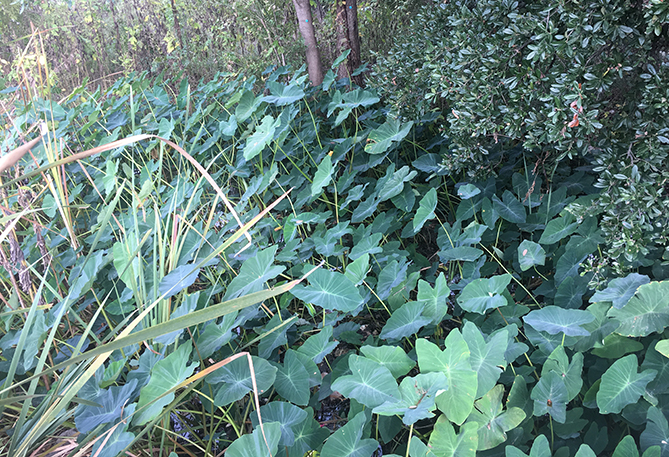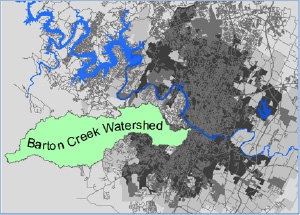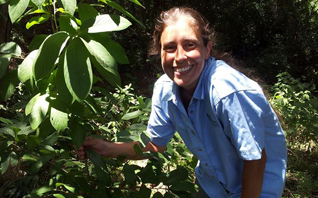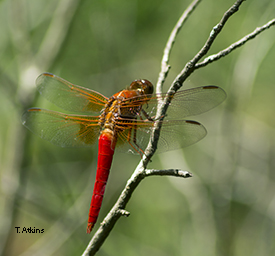Our Department gets calls from concerned community members about unusual colors seen in creeks. Some of these vibrant colors are natural, so here’s a quick guide to help identify some of the possible sources that cause these unusual sights.
Our environmental scientists encounter a lot of strange and colorful things in our creeks. Orange slime, purple fluffy goo, and rainbow sheens on the water would all appear to be pollution problems, but often it is just a natural phenomenon. Each of these things can be harmless bacteria just doing what they normally do, which is abnormally fascinating. If you suspect what you are seeing is not naturally occurring and a pollution source…
With a healthy creek here and a dirty creek there, how do we measure creek health? The Environmental Integrity Index (EII) is a program designed to continuously monitor and assess the water quality of Austin’s creeks and streams.
Austin’s creeks once ran clear in the wilderness, but now they run through the wilds of the city, picking up pollution and absorbing runoff from impervious cover and heavy rain storms. In order to understand how these urban challenges affect our creeks and develop policies that can protect them, the City of Austin uses a program called the Environmental Integrity Index (EII).
…
The shoreline of Lady Bird Lake is home to an amazing array of plants and birds, as well as plenty of turtles, and even a few nutrias. Unfortunately, one non-native nuisance plant has set up shop around the lake and seems to be crowding everything else out.

What it is
Elephant ear (also known as wild taro) is a native of the Asian tropics and has been in Central Texas since at least 1929. On Lady Bird Lake it likes to keep its feet wet right at the water’s edge. It can grow so densely that it prevents oth…
The Mearns Meadow Grow Zone is a beautiful site and would love to be adopted by you!
The Mearns Meadow Grow Zone at Quail Creek Park.
The Mearns Meadow Grow Zone is tucked away in the southwest corner of Quail Creek Park. This park is adjacent to the Restore Rundberg neighborhood revitalization area and has recently been the focus of Keep Austin Beautiful’s Beautify Austin initiative.
(Trivia: The creek running through Quail Creek Park is actually Little Walnut Creek. There’s…
 The water quality of the Barton Creek Watershed is the best in Austin as evaluated by the 2015 Environmental Integrity Index. Where does your creek stand?
The water quality of the Barton Creek Watershed is the best in Austin as evaluated by the 2015 Environmental Integrity Index. Where does your creek stand?
Ladies and Gentlemen, please put your hands together for the 2015 Watershed Winner of the Environmental Integrity Index……Barton Creek!
This was a to…
This blog was updated in May 2019.
Highly destructive zebra mussels have invaded many popular Central Texas waters, and Austin’s local creeks and Barton Springs Pool are now at risk. Zebra mussels destroy local aquatic ecosystems and hurt visitors (including cutting people’s feet and dogs’ paws). In Barton Springs Pool, an infestation also would likely significantly increase maintenance costs.
Spread the Message, Not the Mussels
People can easily spread this invasive species from one body of water to another without knowing it. Young zebra mussels are invisible to the naked eye, and millions of them can live undetected on wet items for da…
 What happens when you stop mowing along the edge of the creek? You create a Grow Zone. Yes, once you remove the disturbance that is keeping the edge of the creek from becoming a riparian forest, it will start growing back. The first plants to exercise the right over the new place are pioneers that can withstand the degraded soils and harsh conditions created by mowing. Giant Ragweed is often the most common and vigorous one! Thanks to birds and wind bringing tree seeds to the new Grow Zon…
What happens when you stop mowing along the edge of the creek? You create a Grow Zone. Yes, once you remove the disturbance that is keeping the edge of the creek from becoming a riparian forest, it will start growing back. The first plants to exercise the right over the new place are pioneers that can withstand the degraded soils and harsh conditions created by mowing. Giant Ragweed is often the most common and vigorous one! Thanks to birds and wind bringing tree seeds to the new Grow Zon…
Habitat=more fish
In aquatic systems, an important component of the ecosystem is the type and abundance of “habitat” present. Habitat, also referred to as “structure”, are things such as submerged aquatic plants, emergent aquatic plants and floating periphyton, overhanging trees, and large woody debris. These components provide the materials, surfaces, and niches upon which algae and microorganisms colonize, insects can feed and breed, and small and large fish can spawn, feed, hunt, and hide. Together, habitat supports, diversifies, and enhances the food web of aquatic systems.
…
 Spotted! This Neon Skimmer (Libellula croceipennis) was spotted here in Austin! A native to Texas, the neon skimmer can also be found around the Southwest including Arizona and Southern California. Known for its vivid red color and unusual mating patterns, skimmers are often seen hanging out around lakes and ponds in Central Texas. Their mating ritual is quite e…
Spotted! This Neon Skimmer (Libellula croceipennis) was spotted here in Austin! A native to Texas, the neon skimmer can also be found around the Southwest including Arizona and Southern California. Known for its vivid red color and unusual mating patterns, skimmers are often seen hanging out around lakes and ponds in Central Texas. Their mating ritual is quite e…

